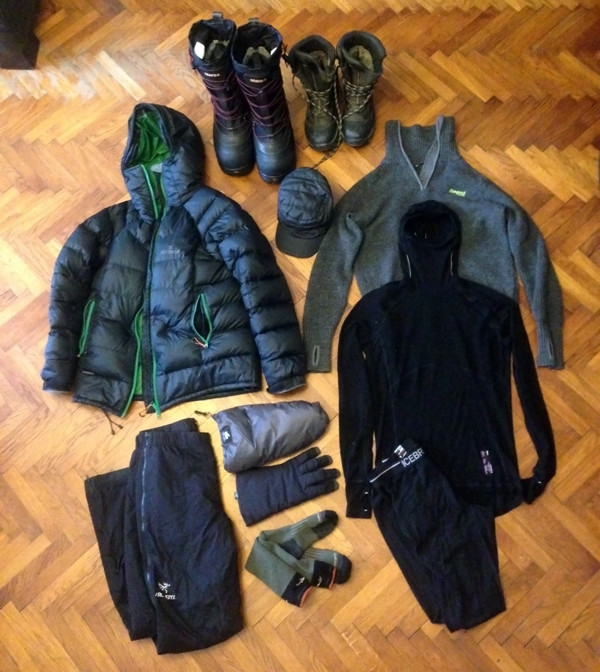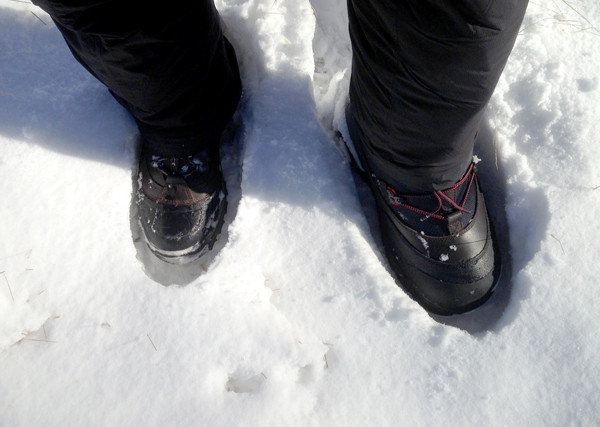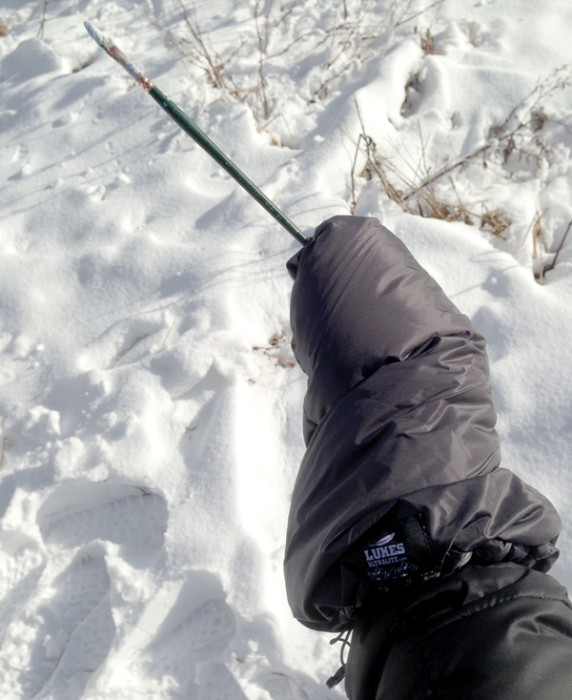
My 2016 winter kit.
“There’s no such thing as bad weather, only unsuitable clothing.”
― A. Wainwright
Last year I wrote about the problems I was having painting outside in the Austrian Alps in February due to inadequate winter gear. This post is about some of the solutions I found after researching and purchasing kit this year. The listed price on some of this stuff is pretty high but buying in spring and summer, using sites like Steep and Cheap or Ebay, and finding an online store that I’m pretty sure had listed the wrong prices (they’ve since fixed them) allowed me to pick up most items for a fraction of the normal cost. And some items are just well worth the money.
My goal getting this kit was to be able to work outside all year without feeling any discomfort, despite the fact that I get cold really easily. I’m really happy with my current setup. It also breaths well so I can trudge around in the snow looking for my view without getting too hot. Furthermore, merino and down both regulate temperature rather than just insulating so I find I don’t have to change in and out of layers as the sun and/or wind comes and goes.
- The Belay Jacket. A belay jacket is used by alpinists when they have to stop and wait around while climbing mountains. The advantages for plein air painters are threefold. First, the design of the sleeves is to allow for unrestricted movement while climbing (called articulated sleeves). This means that when painting you wont fight your sleeve. The second plus is that they are incredibly lightweight as they are usually stuffed into a stuff-sack and carried up the mountain. They use high-loft down or modern synthetic insulation (you can read about down and synthetic down jackets here) and this, combined with the articulated sleeves, means you really can’t feel the jacket at all when you’re holding your arm up. A normal winter jacket or parka will often have a noticeable pull. The real-world result is that I haven’t had my usual sore shoulder for a few days when I switched to a jacket this year. It’s not that big of a deal, but it is something to consider for anyone looking to pick up a dedicated winter plein air coat. The third thing about belay jackets is that they are very warm so you don’t need many layers to stay warm (though most decent winter jackets do fine here). Mountain Hardware, Rab, Arcteryx, Patagonia, and other mountaineering-gear companies all make belay jackets or parkas. For cottage companies, PHD (England), and Feathered Friends, Montbell (Japan), and Nunatak in the US are also making belay and expedition jackets and parkas. There are both down and synthetic versions. I went with down for the weight to warmth ratio. The synthetic ones will keep you warm even if they get wet, which seems to me to be more of an issue if your life depends on it high up on a mountain.
Update for 2020: I’ve switched to a waterproof Crux Magma and it’s much better. The problem with many belay jackets is they’re design for use with a shell in rain or snow, but for a painter you lose too much dexterity with two layers. The Crux has great mobility in the shoulders and is incredibly light and warm. And it’s completely waterproof, so you don’t have to worry about staying out too long in precipitation.
- Mid-layer Sweaters. I bought a couple of ‘technical’ merino sweaters of different fabric weights that I switch depending on the temperature. They’re not stiff like some of the heavy sweaters I wore in the past to make up for my jackets never being warm enough. My favorite is a Bergans of Norway merino wool sweater that was reasonably priced and has a half-zipper to regulate the temperature better. It also comes with thumb-holes in case I ever need to do whatever it is you need thumb-holes for.
Update for 2020: Yak Wool sweaters from Khunu are much warmer for their weight than merino. Unfortunately they sell out quickly. I will wear a fleece over the sweater when it’s really cold.
- Merino Base Layers. I had a hard time finding expedition weight pure merino base layers in stores in continental Europe. As I mentioned last time, synthetic base layers are more designed for very active use, where wicking away sweat is important. For standing still the best thing I’ve found is a heavy weight merino base layer. This year I’m using 260 weight (gsm) leggings from Icebreaker and a 340 weight Deep Winter Base Layer top from Rapha, an English cycling gear company. The Rapha base layer is pricey but if you consider it’s also a balaclava and neck gaiter, as well as being a very high-quality piece of kit, it’s pretty reasonable. I’m very happy with mine. It’s one of the only things I paid full retail price for and I feel it was well worth it. Minus33 makes heavier duty baselayers (400 gsm), but we can’t get their stuff over here. Woolpro is a cottage company making merino gear in the US.
Update for 2020: I’ve switched to yak wool baselayers from Kora and find them warmer than merino for the same weight.

Size difference between Harkila Inuit pac boots and normal winter boots.
- Pac Boots. I’ve always gotten by with cheap hiking boots with hand warmers stuffed in the toes. Other painters use normal insulated winter boots with their car mats or a piece of foam under their feet as most of the cold comes from touching the freezing ground. I wanted something that I could work outside for hours in without carrying extra gear so I picked up a pair of real pac boots based on Stapleton Kearns‘ recommendation of The Cabelas Trans-Alaskan III Pac Boots. Since we don’t have Cabelas in Europe I bought the similar-looking Harkila Inuits for the around the same price. They’re comically large boots, and online images don’t really show how big they are. You can’t drive while wearing them, so for scouting with a car one still needs a smaller winter boot to use the pedals safely. Like all pac boots, they’re actually two boots in one as there is an inner wool insert that your foot goes into, then that goes into the larger boot. They also have two insoles below the insert and my feet are kept about 4 inches (10 cm) off the ground. Despite the large size, the boots are actually very light and manageable for walking as the insoles are foam and the sole of the boot appears to be hollow, perhaps to insulate better. The important part is that I can stand for hours on snow and ice in complete comfort.
- Primaloft/Coreloft pants. A number of companies make insulated pants, again mainly for belaying mountaineers. The difference between these and insulated ski pants is that they lack the Goretex or other durable waterproofing. I bought a pair of Arcteryx’s Atom pants made from their proprietary Coreloft insulation and it really feels like some sort of futuristic fabric. When you move the pants feel slightly cool on your legs so you don’t get warm, but when you stand still they really insulate well. They don’t swish when you walk like ski-pants and they look pretty discrete for working in them in the city. They were also significantly cheaper in Europe than the US for some reason. I have a Gore-Tex shell for when it rains and a good thing about dividing the insulation and the shell is that I can tune the clothes for the temperature better. I also use the shell for rain in warmer weather.
- Flannel-lined pants. I bought a couple of pairs of flannel-lined pants and can’t believe I’ve suffered through European winters for 25 years without them. Besides being incredibly warm, they’re so comfy. It’s like wearing pajamas all day. I live in these now. I have a pair of Pranas and Craghoppers, the Pranas are much nicer as the lining is pure cotton and doesn’t cling to your legs. The Craghoppers are warmer as the synthetic material use doesn’t breathe as well. The Pranas cost twice as much. That said, for painting outside in the snow, I prefer the Coreloft pants as the side zipper makes it easier to switch from car-friendly shoes to pac boots.
- Primaloft hats. The hood on the Jottnar jacket is very warm but I prefer wearing a hat so I can keep my peripheral vision. Outdoor Research, Montane, and Millet all make radar-style hats out of Primaloft (probably other companies too). I have the Millet one and insulates well, is water-resistant, and still breaths. I also think I look very French in it, which is always a good thing when painting outside.
- Gloves for the non-painting hand. Update for 2017: I’ve switched to bicycling gloves for the non-painting hand. Garneau, Pearl Izumi, Castelli, Rapha, ect… all make gloves for bicycling in winter and I find that they have better dexterity and grip than ski or alpinist gloves.
Custom-made down Hibbard mitten from Luke’s Ultralight.
- Custom-Made Down Hibbard Mitten. In the past I’ve used a wool scarf sewn into a thumbless-mitten-shape to keep my painting hand warm. The design is called a Hibbard mitten after Aldro Hibbard who painted a lot outside in the New England winters. (Update for 2018) I had one made by Goosefeet Gear, a custom down-gear maker. It works great. It’s very warm and weighs only half an ounce (15g) so you barely feel it on your hand. It also comes with a removable waterproof shell for snow and rain. I should mention that with any Hibbard mitten I don’t wear it the whole time. I prefer to keep my hand exposed to handle the brush better, when it gets cold I put the mitten on until it warms up enough to take it off again.
- Khunu Yak-Wool Socks. For warmth, these are really better than any other brand I’ve found.

This all excellent information. I wish I’d had it when I was painting winters in Vermont and Canada! But it makes me want to go back just so I can try it out and experience snow painting in true comfort.
I’ve been part of the lightweight backpacking “movement” for about five or six years, although truthfully backpackers – the hiker rather than city visitor type – have always been interested in lowering the weight of what they carry. So it’s really interesting for me to see how you have gone about lightning up your painting equipment and – because I now live in Norway as opposed to England after meeting a lightweight backpacker here – how you manage being outside, usually stationary, in the European winters.
A lot of the kit you refer to – and links (Lukes, Section Hiker) – is stuff that i’ve coincidentally come across, and I’m really excited to learn from you how to brave the winter and just get out and paint. I must admit I’ve been a bit chicken, but you’re certainly showing it’s more than possible, albeit looking like the Staypuft Man – thank you!
Great article! I’m a plein air painter in western Colorado. One thing I take with me is a fleece neck gaitor. Its great for keeping one’s neck warm, you came pull it up over your ears for another layer if needed, or it can become an impromptu headband when it warms up too much for a hat.
I love when you write these “gear” posts. I think the buyer of a panel should appreciate them more knowing what you went through to make them.